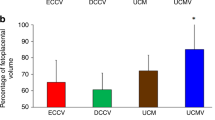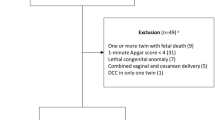Abstract
Objective:
To compare the effect of early and late cord clamping (LCC) on neonatal hematocrit at 2 and 18 h of life.
Study Design:
In this double-blind randomized trial, 64 healthy full-term vaginally born neonates were randomly allocated to either early (30 s) or late (3 min) umbilical cord clamping. During the interval between delivery and cord clamping, the attendant held the neonate supine at the level of the introitus. Neonatal venous hematocrit was measured at 2 and 18 h of life.
Result:
Neonatal hematocrit at 2 h of life (61±4.9 vs 61.6±4.5%) and 18 h of life (56.9±4.1 vs 56.2±3.9%) was not significantly different between the two groups. This was also true for neonatal polycythemia (20 vs 23.5%). In the LCC group, placental residual blood volume (PRBV) was 39.5% lower and estimated neonatal blood volume (ENBV) was 7.1% higher than that in the early cord clamping (ECC) group (P<0.001).
Conclusion:
Late cord clamping does not lead to a significant difference in the hematocrit level of the neonate or neonatal polycythemia, but is associated with a significant increase in ENBV and a significant decrease in PRBV. Further trials should examine the effect of delaying cord clamping for a longer period of time or changing the position that the neonate is held in to determine whether these variations result in more clinically significant results.
This is a preview of subscription content, access via your institution
Access options
Subscribe to this journal
Receive 12 print issues and online access
$259.00 per year
only $21.58 per issue
Buy this article
- Purchase on Springer Link
- Instant access to full article PDF
Prices may be subject to local taxes which are calculated during checkout

Similar content being viewed by others
References
Ibrahim HM, Krouskop RW, Lewis DF, Dhanireddy R . Placental transfusion: umbilical cord clamping and preterm infants. J Perinatol 2000; 20: 351–354.
McDonnell M, Henderson-Smart DJ . Delayed umbilical cord clamping in preterm infants: a feasibility study. J Paediatr Child Health 1997; 33: 308–310.
Lozoff B, Yimenez E, Wolf AW . Long term development outcome in infants with iron deficiency. N Eng J Med 1991; 325: 687–694.
Mercer JS . Current best evidence: a review of the literature on umbilical cord clamping. J Midwifery Women Health 2001; 46 (6): 402–412.
Rabe H, Reynolds G, Diaz-Rosselloy J . Early versus delayed umbilical cord clamping in preterm infants. Cochrane Database Syst Rev 2004; 18 (4): CD003248.
Van Rheenen P, Brabin BJ . Late umbilical cord-clamping as an intervention for reducing iron deficiency anemia in term infants in developing and industrialised countries: a systematic review. Ann Trop Pediatr 2004; 24 (1): 3–16.
Mercer JS, Skovgaard RL . Neonatal transitional physiology: a new paradigm. J Perinat Neonatal Nurs 2002; 15 (4): 56–75.
Jones JG, Holland BM, Hudson IR, Wardrop GA . Total circulating red cells versus hematocrit as the primary descriptor of oxygen transport by the blood. Br J Haematol 1990; 76: 288–294.
Grajeda R, Preze-Eschamilla R, Dewey KG . Delayed clamping of the umbilical cord improves hematologic status of Guatemalan infants at 2mo of age. Am Clin Nutr 1997; 65: 425–431.
Linderkamp O, Nelle M, Kraus M, Zilow EP . The effect of early and late cord clamping on blood viscosity and other hemorheological parameters in full-term neonates. Acta Paediatrica 1992; 81: 745–750.
Yao AC, Moiniam M, Lind J . Distribution of blood between infant and placenta after birth. Lancet 1969; 762: 871–873.
Fanaroff A, Mortin RJ . Neonatal-Perinatal Medicine: Disease of the Fetus and Infant, 7th edn. Mosby: New York, 2002.
Nelle M, Zilow EP, Kraus M, Bastert G, Linderkamp O . The effect of leboyer delivery on blood viscosity and other hemorheologic parameters in term neonates. Am J Obstet Gynecol 1993; 169 (1): 19–93.
Ingomar CJ, Klebe JG, Baekgaard P . The transcapillary escape rate of T-1824 in healthy newborn infants. The influence of the placental transfusion. Acta Paediatr Scand 1973; 62: 617–620.
Acknowledgements
The Research deputy of Mashad University of Medical Sciences financially supported this study. We thank Dezyani hospital of Gorgan midwives for their cooperation in the data collection and Mohammad Roshani for revising the paper.
Author information
Authors and Affiliations
Corresponding author
Rights and permissions
About this article
Cite this article
Jahazi, A., Kordi, M., Mirbehbahani, N. et al. The effect of early and late umbilical cord clamping on neonatal hematocrit. J Perinatol 28, 523–525 (2008). https://doi.org/10.1038/jp.2008.55
Received:
Revised:
Accepted:
Published:
Issue Date:
DOI: https://doi.org/10.1038/jp.2008.55



